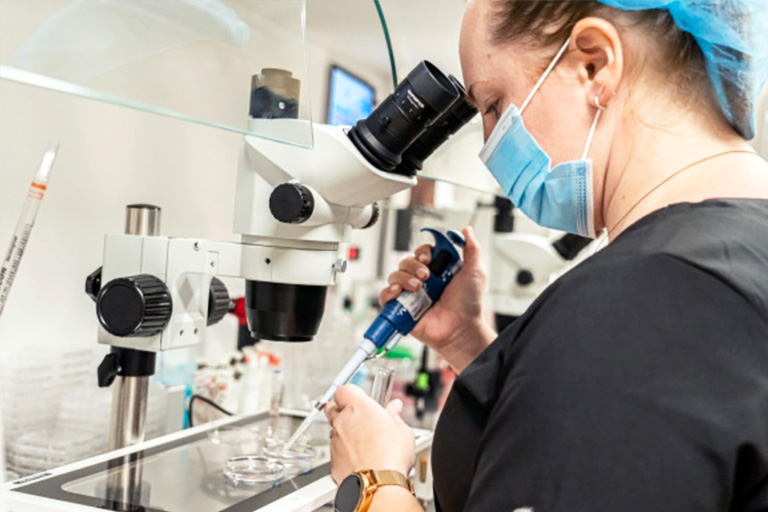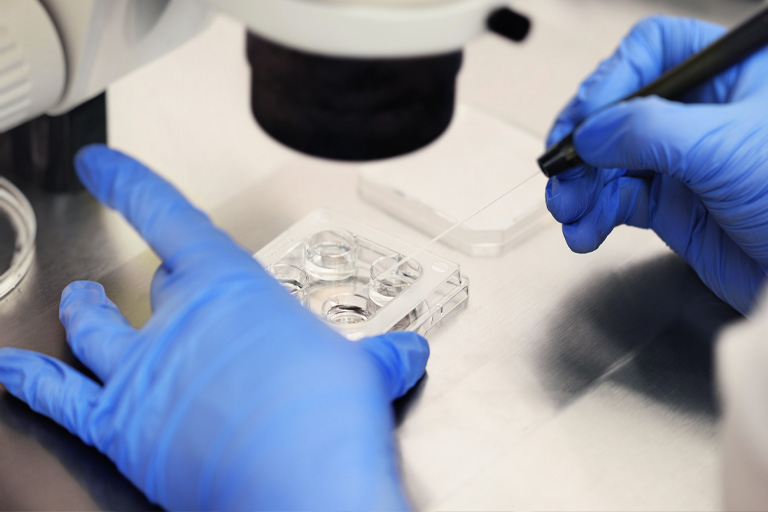In vitro fertilization (IVF) is a procedure in which the sperm and egg are combined outside the woman’s body in a lab. After they are combined, the fertilized eggs are transferred to the woman’s uterus. It is a type of assisted reproductive technology (ART).
About the Procedure
In vitro fertilization involves several steps:
- Ovulation induction
- Egg retrieval
- Sperm retrieval
- Fertilization
- Embryo transfer
Ovulation Induction
For women using their own eggs for IVF, the cycle begins with ovulation induction. Hormonal medications are given to stimulate the ovaries to produce multiple eggs. Other medications may be given to mature the eggs, prevent premature ovulation, and prepare the lining of the uterus for implantation.
During ovulation induction, the fertility specialist carefully monitors hormone levels with blood tests to determine when the eggs are ready for retrieval. They also use transvaginal ultrasound imaging to monitor the ovaries and the development of follicles. Ovulation induction usually lasts about two weeks.
Egg Retrieval
After the eggs are mature, egg retrieval takes place at the fertility clinic. The fertility specialist uses a special needle guided by ultrasound imaging to remove the mature eggs from the follicles. The eggs are then placed in a special liquid and incubated to prepare for fertilization.
Sperm Retrieval & Preparation
The male partner provides a semen sample at the doctor’s office or clinic on the morning of the egg retrieval so it can be prepared for fertilization. Donor sperm can also be used and will also need to be prepared for fertilization. A special washing process separates the sperm from the other materials such as seminal fluid.
Fertilization
In the lab, a specialist called an embryologist combines the healthiest portion of the sperm and mature eggs and incubates them. Fertilization may be attempted using either conventional insemination or a process called intracytoplasmic sperm injection (ICSI), in which a single sperm is injected directly into a mature egg.
Embryo Transfer
The embryo transfer is done at the fertility clinic five days after the transfer. During the procedure, the embryos are transferred to the uterus through a long, thin, flexible tube called a catheter. If the transfer is successful, an embryo will implant in the uterine lining. After a one-week wait, a pregnancy test can be done.
Why In Vitro Fertilization is Performed
In vitro fertilization is an effective treatment for many causes of infertility. Because fertilization takes place outside of the woman’s body, IVF is a good option for people who have the following fertility issues:
- Ovulation disorders: If ovulation is irregular or absent, then the chances of conception are reduced. IVF stimulates ovulation so multiple eggs can be retrieved, fertilized, and transferred to the uterus.
- Fallopian tube damage or blockage: When one or both of the fallopian tubes are damaged or blocked, it makes it difficult for the egg to be fertilized and for the embryo to travel to the uterus.
- Endometriosis: Endometriosis is a condition in which the tissue that lines the uterine lining (called endometrial tissue) grows outside the uterus. It can impair fertility by affecting the function of the ovaries, uterus, and fallopian tubes.
- Uterine fibroids: Fibroids are benign tumors that develop in the wall of the uterus. Fibroids are common and don’t always cause issues with fertility, but can sometimes interfere with egg fertilization and implantation.
- Unexplained infertility: No cause of infertility has been found after both partners have been evaluated for common causes.
The expert providers at West Virginia Fertility Institute specialize in a variety of treatments for infertility, including in vitro fertilization. We combine personalized care with cutting-edge technology to help our patients build their families. Call our office at (304) 345-9292 to schedule a consult.


